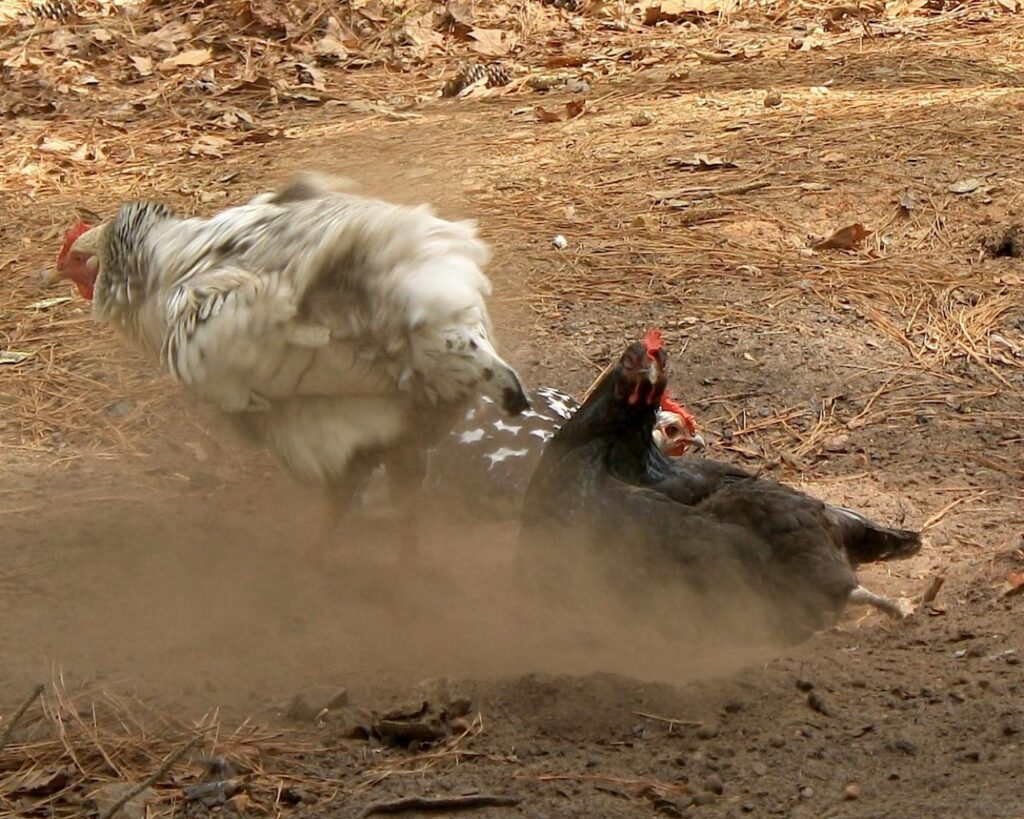A chicken’s dust bath is an important part of its wellbeing programme. Their dust bathing is valuable for a number of reasons.
What is a chicken’s dust bath?
Some decades ago, when we were naïve newbie maplotters, we acquired our first chickens. Well, the very first was curtesy of our dog, who arrived with a most irate cockerel in her mouth, which she gently offered to us with great pride. But that is, we are told, a story for another day. Suffice to say, we managed to provide him with a couple of wives.
But imagine our dismay when we went out one day to find our pride and joy of a rooster who seemed to be thrashing around in a hollow of ground, looking as if he was having a kind of fit. He had burrowed a patch for himself in the ground and seemed to be throwing sand over himself. He was scratching at the sand and wiggling in it.

Then we noticed that he was joined by his hens, who similarly crouched down into the soil and seemed to be really enjoying the sensation of sand in their feathers and on their skin.
Why do chickens dust bathe?
We discovered that chickens bathe in sand for a number of reasons. Ironically it’s a way of cleaning themselves. The dust absorbs excess oil that might have been secreted.
It also helps to get rid of external parasites such as mites, ticks and fleas. The dust makes it difficult for them to breathe and they will jump off the chicken. These parasites can cause damage to the health of the chicken, so this habit of getting rid of them is important.
Not only is dust bathing a relaxing pastime, it is also a social activity. When one starts to wriggle and flap around in the sand, others will follow suit, with accompanying sounds of pleasure.
Provide a space for dust bathing
If your chickens live in a coop, make sure that there is a sandy area for them to bathe. They like to do this in sunny spots. If the area is covered in grass or other plants, you might have to clear some of it to prepare a dust bathing patch.
There are various materials that you can add to it as well.
If you have a clayey soil spread some fine sand in the dust bath.
Some smallholders swear by diatomaceous earth (DE). This helps with keeping the parasites at bay. It will clog up the breathing passages of external bloodsuckers. If the chickens peck at the DE and swallow some of it, DE controls internal parasites such as worms. Make sure that it is food grade DE. Wear a mask when handling it, as it can be a lung irritant to humans.
Some chicken keepers add wood ash to the sand in the dust bath. This contains some minerals and is said to absorb toxins from the chickens’ feathers. Make sure that there is no trace of lighter fluid in the ash.

There are certain herbs that are good for the feathers and skin. Sprinkle fresh or dried rosemary, thyme, mint or lavender. They too act as insecticides. We are told that khakibos is also good for discouraging pests.
If you only have space for one dusting area be sure to clean it frequently and vary the material that you spread in it.
To receive all our notices and each edition of SA Smallholder register here.
To read other articles about poultry click here.

